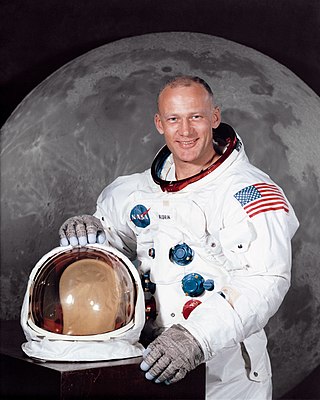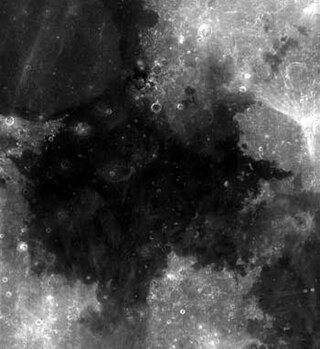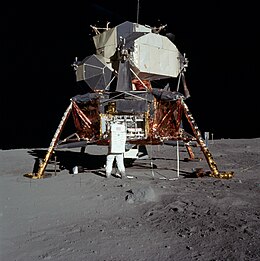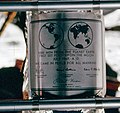
Apollo 11 was the American spaceflight that first landed humans on the Moon. Commander Neil Armstrong and Lunar Module Pilot Buzz Aldrin landed the Apollo Lunar Module Eagle on July 20, 1969, at 20:17 UTC, and Armstrong became the first person to step onto the Moon's surface six hours and 39 minutes later, on July 21 at 02:56 UTC. Aldrin joined him 19 minutes later, and they spent about two and a quarter hours together exploring the site they had named Tranquility Base upon landing. Armstrong and Aldrin collected 47.5 pounds (21.5 kg) of lunar material to bring back to Earth as pilot Michael Collins flew the Command Module Columbia in lunar orbit, and were on the Moon's surface for 21 hours, 36 minutes before lifting off to rejoin Columbia.

Apollo 8 was the first crewed spacecraft to leave low Earth orbit and the first human spaceflight to reach the Moon. The crew orbited the Moon ten times without landing, and then departed safely back to Earth. These three astronauts—Frank Borman, James Lovell, and William Anders—were the first humans to witness and photograph the far side of the Moon and an Earthrise.

The Apollo program, also known as Project Apollo, was the United States human spaceflight program carried out by the National Aeronautics and Space Administration (NASA), which succeeded in preparing and landing the first men on the Moon from 1968 to 1972. It was first conceived in 1960 during President Dwight D. Eisenhower's administration as a three-person spacecraft to follow the one-person Project Mercury, which put the first Americans in space. Apollo was later dedicated to President John F. Kennedy's national goal for the 1960s of "landing a man on the Moon and returning him safely to the Earth" in an address to Congress on May 25, 1961. It was the third US human spaceflight program to fly, preceded by the two-person Project Gemini conceived in 1961 to extend spaceflight capability in support of Apollo.

Apollo 9 was the third human spaceflight in NASA's Apollo program. Flown in low Earth orbit, it was the second crewed Apollo mission that the United States launched via a Saturn V rocket, and was the first flight of the full Apollo spacecraft: the command and service module (CSM) with the Lunar Module (LM). The mission was flown to qualify the LM for lunar orbit operations in preparation for the first Moon landing by demonstrating its descent and ascent propulsion systems, showing that its crew could fly it independently, then rendezvous and dock with the CSM again, as would be required for the first crewed lunar landing. Other objectives of the flight included firing the LM descent engine to propel the spacecraft stack as a backup mode, and use of the portable life support system backpack outside the LM cabin.

Apollo 10 was the fourth human spaceflight in the United States' Apollo program and the second to orbit the Moon. NASA, the mission's operator, described it as a "dress rehearsal" for the first Moon landing. It was designated an "F" mission, intended to test all spacecraft components and procedures short of actual descent and landing.

Apollo 12 was the sixth crewed flight in the United States Apollo program and the second to land on the Moon. It was launched on November 14, 1969, by NASA from the Kennedy Space Center, Florida. Commander Charles "Pete" Conrad and Lunar Module Pilot Alan L. Bean performed just over one day and seven hours of lunar surface activity while Command Module Pilot Richard F. Gordon remained in lunar orbit.

Apollo 14 was the eighth crewed mission in the United States Apollo program, the third to land on the Moon, and the first to land in the lunar highlands. It was the last of the "H missions", landings at specific sites of scientific interest on the Moon for two-day stays with two lunar extravehicular activities.

Apollo 17 was the eleventh and final mission of NASA's Apollo program, the sixth and most recent time humans have set foot on the Moon or traveled beyond low Earth orbit. Commander Gene Cernan and Lunar Module Pilot Harrison Schmitt walked on the Moon, while Command Module Pilot Ronald Evans orbited above. Schmitt was the only professional geologist to land on the Moon; he was selected in place of Joe Engle, as NASA had been under pressure to send a scientist to the Moon. The mission's heavy emphasis on science meant the inclusion of a number of new experiments, including a biological experiment containing five mice that was carried in the command module.

Neil Alden Armstrong was an American astronaut and aeronautical engineer who in 1969 became the first person to walk on the Moon. He was also a naval aviator, test pilot, and university professor.

Buzz Aldrin is an American former astronaut, engineer and fighter pilot. He made three spacewalks as pilot of the 1966 Gemini 12 mission. He was the Lunar Module Eagle pilot on the 1969 Apollo 11 mission and became the second person to walk on the Moon after mission commander Neil Armstrong.

The Apollo Lunar Module, originally designated the Lunar Excursion Module (LEM), was the lunar lander spacecraft that was flown between lunar orbit and the Moon's surface during the United States' Apollo program. It was the first crewed spacecraft to operate exclusively in the airless vacuum of space, and remains the only crewed vehicle to land anywhere beyond Earth.

Mare Tranquillitatis is a lunar mare that sits within the Tranquillitatis basin on the Moon. It is the first location on another celestial body to be visited by humans.

Apollo 5, also known as AS-204, was the uncrewed first flight of the Apollo Lunar Module (LM) that would later carry astronauts to the surface of the Moon. The Saturn IB rocket bearing the LM lifted off from Cape Kennedy on January 22, 1968. The mission was successful, though due to programming problems an alternate mission to that originally planned was executed.

The Apollo spacecraft was composed of three parts designed to accomplish the American Apollo program's goal of landing astronauts on the Moon by the end of the 1960s and returning them safely to Earth. The expendable (single-use) spacecraft consisted of a combined command and service module (CSM) and an Apollo Lunar Module (LM). Two additional components complemented the spacecraft stack for space vehicle assembly: a spacecraft–LM adapter (SLA) designed to shield the LM from the aerodynamic stress of launch and to connect the CSM to the Saturn launch vehicle and a launch escape system (LES) to carry the crew in the command module safely away from the launch vehicle in the event of a launch emergency.
The Apollo Applications Program (AAP) was created as early as 1966 by NASA headquarters to develop science-based human spaceflight missions using hardware developed for the Apollo program. AAP was the ultimate development of a number of official and unofficial Apollo follow-on projects studied at various NASA labs. However, the AAP's ambitious initial plans became an early casualty when the Johnson Administration declined to support it adequately, partly in order to implement its Great Society set of domestic programs while remaining within a $100 billion budget. Thus, Fiscal Year 1967 ultimately allocated $80 million to the AAP, compared to NASA's preliminary estimates of $450 million necessary to fund a full-scale AAP program for that year, with over $1 billion being required for FY 1968. The AAP eventually led to Skylab, which absorbed much of what had been developed under Apollo Applications.

Tranquility Base is the site on the Moon where, in July 1969, humans landed and walked on a celestial body other than Earth for the first time. On July 20, 1969, Apollo 11 crewmembers Neil Armstrong and Buzz Aldrin landed their Apollo Lunar Module Eagle at approximately 20:17:40 UTC. Armstrong exited the spacecraft six hours and 39 minutes after touchdown, followed 19 minutes later by Aldrin. The astronauts spent two hours and 31 minutes examining and photographing the lunar surface, setting up several scientific experiment packages, and collecting 47.5 pounds (21.5 kg) of dirt and rock samples for return to Earth. They lifted off the surface on July 21 at 17:54 UTC.

The Altair spacecraft, previously known as the Lunar Surface Access Module or LSAM, was the planned lander spacecraft component of NASA's cancelled Constellation program. Astronauts would have used the spacecraft for landings on the Moon, which was intended to begin around 2019. The Altair spacecraft was planned to be used both for lunar sortie and lunar outpost missions.

Third-party evidence for Apollo Moon landings is evidence, or analysis of evidence, about the Moon landings that does not come from either NASA or the U.S. government, or the Apollo Moon landing hoax theorists. This evidence provides independent confirmation of NASA's account of the six Apollo program Moon missions flown between 1969 and 1972.























